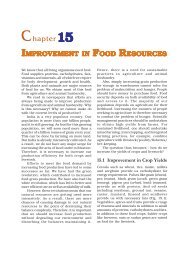C
Create successful ePaper yourself
Turn your PDF publications into a flip-book with our unique Google optimized e-Paper software.
1.3 States of Matter<br />
Observe different types of matter around you.<br />
What are its different states? We can see that<br />
matter around us exists in three different<br />
states– solid, liquid and gas. These states of<br />
matter arise due to the variation in the<br />
characteristics of the particles of matter.<br />
Now, let us study about the properties of<br />
these three states of matter in detail.<br />
1.3.1 THE SOLID STATE<br />
Activity _____________ 1.9<br />
• Collect the following articles— a pen, a<br />
book, a needle and a piece of thread.<br />
• Sketch the shape of the above articles<br />
in your notebook by moving a pencil<br />
around them.<br />
• Do all these have a definite shape,<br />
distinct boundaries and a fixed<br />
volume?<br />
• What happens if they are hammered,<br />
pulled or dropped?<br />
• Are these capable of diffusing into each<br />
other?<br />
• Try compressing them by applying<br />
force. Are you able to compress them?<br />
All the above are examples of solids. We<br />
can observe that all these have a definite<br />
shape, distinct boundaries and fixed volumes,<br />
that is, have negligible compressibility. Solids<br />
have a tendency to maintain their shape when<br />
subjected to outside force. Solids may break<br />
under force but it is difficult to change their<br />
shape, so they are rigid.<br />
Consider the following:<br />
(a) What about a rubber band, can it<br />
change its shape on stretching? Is it<br />
a solid?<br />
(b) What about sugar and salt? When<br />
kept in different jars these take the<br />
shape of the jar. Are they solid?<br />
(c) What about a sponge? It is a solid<br />
yet we are able to compress it. Why?<br />
All the above are solids as:<br />
• A rubber band changes shape under<br />
force and regains the same shape when<br />
the force is removed. If excessive force is<br />
applied, it breaks.<br />
• The shape of each individual sugar or<br />
salt crystal remains fixed, whether we<br />
take it in our hand, put it in a plate or in<br />
a jar.<br />
• A sponge has minute holes, in which<br />
air is trapped, when we press it, the air<br />
is expelled out and we are able to<br />
compress it.<br />
1.3.2 THE LIQUID STATE<br />
Activity _____________1.10<br />
• Collect the following:<br />
(a) water, cooking oil, milk, juice, a<br />
cold drink.<br />
(b) containers of different shapes. Put<br />
a 50 mL mark on these containers<br />
using a measuring cylinder from<br />
the laboratory.<br />
• What will happen if these liquids are<br />
spilt on the floor?<br />
• Measure 50 mL of any one liquid and<br />
transfer it into different containers one<br />
by one. Does the volume remain the<br />
same?<br />
• Does the shape of the liquid remain the<br />
same ?<br />
• When you pour the liquid from one<br />
container into another, does it flow<br />
easily?<br />
We observe that liquids have no fixed<br />
shape but have a fixed volume. They take up<br />
the shape of the container in which they are<br />
kept. Liquids flow and change shape, so they<br />
are not rigid but can be called fluid.<br />
Refer to activities 1.4 and 1.5 where we<br />
saw that solids and liquids can diffuse into<br />
liquids. The gases from the atmosphere<br />
diffuse and dissolve in water. These gases,<br />
especially oxygen and carbon dioxide, are<br />
essential for the survival of aquatic animals<br />
and plants.<br />
All living creatures need to breathe for<br />
survival. The aquatic animals can breathe<br />
under water due to the presence of dissolved<br />
oxygen in water. Thus, we may conclude that<br />
solids, liquids and gases can diffuse into<br />
liquids. The rate of diffusion of liquids is<br />
4<br />
SCIENCE
















